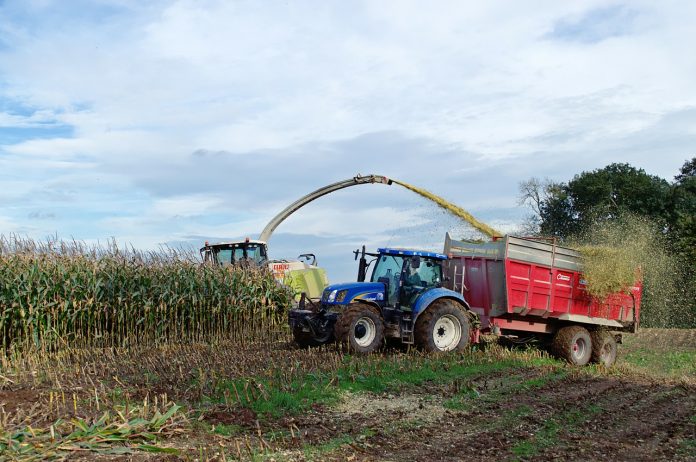As another corn silage harvest draws near, are you prepared to produce a high-quality silage? Corn silage is an important component of dairy rations and with feed costs generally accounting for the greatest variable cost in milk production, it pays to direct management efforts to make high-quality corn silage.
Management decisions and tasks can be divided into pre-harvest and harvest categories.
Before the chopper pulls into the field, make sure all the necessary equipment is lined up and in good repair. Know your harvest capacity in terms of tons of corn chopped per hour.
Do you have the wagons/trucks/tractors to keep up with that capacity? Do you have the labor?
Equipment needs
Don’t forget about the need for packing tractors and drivers. If you use a custom harvester, meet with them well ahead of harvest. Outline your needs and expectations.
Learn what your custom harvester can and can’t do and what time constraints they have. What can you do to improve their harvest efficiency?
Have an idea of when you will start harvest and confirm availability. Think back to preceding years. What areas caused bottlenecks or created stress at harvest?
Anything you can do now to anticipate potential disruptions and plan solutions will pay dividends at harvest. High-quality silage is dependent upon a quick and favorable fermentation process that results in a product that is a highly palatable, stable feed.
Things to consider
Characteristics include a pH below 4.5 and a lactic acid content of 65 percent or greater of the total volatile fatty acids. To accomplish this requires chopping at the correct moisture content, removing the air as quickly as possible after chopping, and maintaining an air/oxygen limiting environment throughout storage.
The foremost step in quality silage production is harvest at the correct moisture/dry matter content (DM). If you don’t get this right, nothing else will matter. A DM range of 30-38 percent is acceptable.
Strive for an average of 35 percent DM. Silage put into a bunker silo should be at the lower end of this range while silage put into upright silos should be at the upper end.
Silage harvest needs to start on the wetter end of the acceptable range because corn will gain DM content or lose moisture on average at .5 percent per day. Rapid harvest is important to ensure corn is chopped within the acceptable moisture range.
Chop length and kernel processing affect the packing/air exclusion properties of silage and impact directly upon silage quality. The theoretical length of cut (TLC) for processed corn silage is 3/4 inches.
Non-processed corn silage should have a TLC of 1/4 to 1/2 inches.
If chop length is too coarse, packing is more difficult, less air is excluded, and the result is poor fermentation.
In recent years, kernel processing has become a standard practice when chopping corn because it damages the protective layer of corn kernels, providing better access to the starch for rumen bacteria.
Upon examination, correctly processed corn silage will not have any visible whole corn kernels or pieces of cob. Most high-quality silage producers use an inoculant.
Quality silage
Can you make high-quality silage without an inoculant? Yes. There are naturally occurring lactic acid bacteria (desirable) in the green chop coming out of the field. At issue, however, are the other naturally occurring bacteria species that compete for the same plant sugars and that produce other acids.
Adding an inoculant can help to speed up the fermentation process that drives lactic acid production. There are two main types of inoculants; homofermenters and heterofermenters.
Homofermenters contain Lactobacillus bacteria that produce lactic acid and heterofermenters contain Lactobacillus buchneri that produce lactic and acetic acid. The lactic acid promoting inoculants increase silage quality by driving the silage pH down quickly and reducing DM loss during the fermentation process.
The buchneri inoculants increase the aerobic stability of silage during feed out. The acetic acid produced prevents yeast growth.
Bill Weiss, OSU dairy nutritionist located at the OARDC in Wooster, says that his standard recommendation regarding inoculant choice is that if you have historically had problems with moldy silage during feed out or if the TMR ration gets hot in the bunk, then use the buchneri type.
If neither of these is an issue, then use the lactic acid promoting type of inoculant.
Correct steps
Regardless of which inoculant type is used, the key is to purchase high-quality inoculants and to apply them correctly.
Do not use chlorine-treated water to rehydrate a bacterial inoculant. After DM content, the next critical step is the rapid removal of air by packing the green chop. This creates a favorable environment for the lactic acid bacteria and the fermentation process.
The goal is to achieve a minimum silage density 40-45 pounds of fresh forage/ ft3, which should provide a density of 15 pounds of DM/ft3 or higher. Higher packing densities result in less DM loss.
The guideline for packing is to provide 800 pounds of packing weight for each ton of silage delivered to the silo or pack.
For example, if the harvest rate is 100 tons/hr. then the packing weight needed is 100 times 800 = 80,000 lbs. or 40 tons. Each packing layer should be no more than 6 inches in thickness.
Another piece of advice from Bill Weiss regarding packing is if you think you have packed enough; pack some more.
Cover the silo or pile as soon as the final packing is completed. Covering prevents oxygen, weather and animals from getting into the silage pack, reducing DM and spoilage losses.
The recommendation is to cover with plastic of 6 to 8 mil thickness and weigh that plastic down, sealing the edges as well.
University research trials have demonstrated that the oxygen barrier two-step products have reduced losses more than covering with the 6 to 8 mil plastic.













